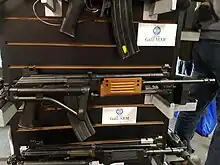| IMI Galil | |
|---|---|
 Galil ARM | |
| Type | Assault rifle Carbine Battle rifle |
| Place of origin | Israel |
| Service history | |
| In service | 1972–present[1] |
| Used by | See Users |
| Wars | |
| Production history | |
| Designer | Yisrael Galili Yakov Lior |
| Manufacturer | Manufactured by:
Licensed by:
|
| Produced | 1972–1998 |
| Variants | See Variants |
| Specifications | |
| Mass |
|
| Length |
|
| Barrel length |
|
| Cartridge |
|
| Action | Gas-operated, rotating bolt |
| Rate of fire |
|
| Muzzle velocity |
|
| Effective firing range | 410 meters (Galil ARM) |
| Feed system |
|
| Sights | Flip-up rear aperture with protective ears, flip-up tritium night sights, hooded front post |
The IMI Galil (Hebrew: גליל) is a family of Israeli-made automatic rifles chambered for the 5.56×45mm NATO and 7.62×51mm NATO cartridges. Originally designed by Yisrael Galili and Yakov Lior in the late 1960s, the Galil was first produced by the state-owned Israel Military Industries and is now exported by the privatized Israel Weapon Industries.
The first Galil rifle was manufactured using RK 62 receivers.[7] Moreover, the Galil design is largely based on the Finnish rifle RK 62 (a derivative of the AK-47).[8] The Galil family of weapons is used by both military and police forces across 25 countries.
The Israeli Army initially deployed the 5.56×45mm NATO Galil in three basic configurations; the Automatic Rifle Machine-gun (ARM),[9] the Automatic Rifle (AR), and the Short Automatic Rifle (SAR). A modern version of the Galil currently in production in multiple calibers is known as the Galil ACE.
History
The Belgian FN FAL battle rifle had initially been adopted by the Israeli Defense Forces in the late 1950s (chambered for the 7.62×51mm cartridge). The FAL had its limitations, a common complaint being that the abundant local sand and dust exposure would cause weapon malfunction (later attributed to lack of stringent maintenance). Overall, however, the FN FAL was considered long and bulky. Its length and malfunctions became such consistent issues that during the 1973 Yom Kippur War some soldiers began arming themselves with the much smaller Uzi.[10][11]
During the Six-Day War the Israelis captured thousands of primarily Egyptian AK-47s. This rifle was proven reliable and controllable. The required maintenance was low enough that conscripted troops had less stringent regulations on the weapon's care.
When the IDF began the process of procuring a new, automatic rifle, the AK-47 was considered, but the difficulty of procurement limited its viability. Hence the IDF specifically sought a weapon that would offer the same benefits as AK-47, such as low maintenance requirements, but would also have the accuracy of the M16 and FN FAL. The would-be standard weapon was originally nicknamed the "Balashnikov".[12] Several weapons were tendered to the Israeli Army, in response to its specifications for a standard-issue assault rifle. These included the M16A1 and Stoner 63 from the USA, and the HK33 (West Germany). An indigenous design was offered by Uziel Gal, creator of the Uzi submachine gun. This was found complex and unreliable.[11]
The successful design was offered by Yisrael Galil, based on the 7.62×39mm Valmet Rk 62, an AK-47 derivative from Finland. (The first Galils were manufactured with Valmet Rk 62 receivers.)[7] At the time, the US was replacing European countries (especially France) as Israel's main partner and weapons supplier. Hence, Galil's rifle was chambered for the US 5.56×45mm round (originally the US M193 55-grain version). Tests conducted from the end of the 1960s to the early 1970s led to Galili's rifle emerging as the winner. However, issuance of the Galil was delayed by the sudden onset of the Yom Kippur War in 1973.[10][11][13]
The Israeli army first used the 5.56×45mm NATO caliber Galil in three basic configurations:
- The Automatic Rifle Machine-gun (ARM) with bi-pod, wire-cutter and carrying handle; would become the standard service rifle issued to front line infantry troops. Also the version that famously features a bottle opener in the front hand-guard.[9]
- The Automatic Rifle (AR) with no bi-pod, wire-cutter or carrying handle. Issued to support troops and military police units.
- The Short Automatic Rifle (SAR) with shortened barrel. Issued to vehicle crews, army staff and specialty troops.
Although the Galil was the official service rifle of Israel from the mid-1970s to the early 1990s, it was never the principal rifle used (in terms of numbers). Around 1975, 60,000 M16A1s from the U.S. Military Aid Program (MAP) began to arrive in Israel that were quickly integrated into IDF service. The cost of producing the Galil for all IDF forces was very expensive, and Israel continued to purchase M16s and later M4s with military credit from the US, which had replaced many Galils then in service. In general, Israeli troops preferred the M16, because it was lighter and more accurate, if not quite as rugged and reliable. When the M4 came along, this weapon (with its short length and light weight) became even more attractive, along with the M4's versatility in using different optics without losing zeroing when the weapon was disassembled, plus other rail-mounted accessories. The M16 and M4 also proved to be better suited to the grenade launching role, using the US M203 integrated 40 mm launcher. Israeli paratroops in particular preferred the M4 carbine to the Galil, while the M16 was retained for training recruits, reservists, Artillery Corps, and the Armored Corps (Heil HaShiryon).[14]
By 2000, both the Galil ARM and AR variants were phased out from standard issue and replaced by M4 and M16 variants. The Galil SAR (G'lilon) was kept in use by some rear-line services, including the Knesset Guard[10] and the Artillery and Armored Corps, until around 2004.
For a short time, the Galil was licensed by NWM (Nederlandsche Wapen-en Munitiefabriek) De Kruithoorn N.V. for sales to a NATO country.[15]
Currently they are only manufactured in Colombia by Indumil, alongside the Galil Ace and the Galil Córdova, the latter of which was designed by Indumil.[16]
400 Galil rifles were purchased through the Antiguan government for the Medelin cartel.[17]
Design details
Operating mechanism
The Galil series of rifles are selective fire weapons operated by a Kalashnikov-pattern gas-driven long-stroke piston system with no regulator. The weapon is locked with a rotary bolt with two locking lugs that lock into recesses milled into the receiver.
When fired, a portion of the propellant gases are evacuated into the gas cylinder through a 1.8 mm (0.07 in) port, drilled at a 30° angle in the barrel, and a channel in the gas block. The high-pressure gases drive the piston rod (which is attached to the bolt carrier) rearward. During this rearward movement, a cam slot machined into the bolt carrier engages a cam pin on the bolt and rotates the bolt, unlocking the action. The arrangement of parts on the bolt carrier assembly provides for a degree of free travel, allowing gas pressure in the barrel to drop to a safe level before unlocking. To the immediate rear of the chrome-plated piston head is a notched ring which provides a reduced bearing surface and alleviates excess gas build-up. As the bolt carrier travels back, it compresses the return spring guided in a hollowed section of the bolt carrier and the return energy contained in the spring drives the moving assembly back forward, stripping a new round from the magazine and locking the action. The cocking handle is attached to the bolt carrier on the right side of the receiver and reciprocates with each shot; the handle is bent upwards allowing for operation with the left hand while the shooting hand remains on the pistol grip.
The ejection of spent cases from the Galil is sometimes a violent action. Cases can be dented by the ejector and be thrown as much as 40 ft away from the rifle in some cases, depending on position.[13]
Features
The Galil is hammer-fired and has a trigger mechanism patterned after the trigger used in the American M1 Garand.[18] The rifle's fire selector switch has three positions: S-A-R. The standard AK-47 style selector is retained on the right face of the receiver, and a dual thumb-selector is present on the left face above the pistol grip for easier manipulation.[19] Pushing the left-selector to the rear position "R" (British terminology for "repetition"), provides semi-automatic fire. Pushing it to the middle position "A" produces fully automatic fire. Pushing the lever fully forward to "S" will activate the safety. Some models use a reverse-linkage RAS mechanism that performs the opposite action; pushing forward sets the rifle to Repetition or Automatic, and pulling rearward engages the safety,
The Galil prototypes used a stamped and riveted sheet metal steel receiver, but due to the higher operating pressures of the 5.56×45mm cartridge, this solution was discarded and the designers turned to a heavy milled forging. As a testament to its heritage, early prototypes were fabricated using Valmet Rk 62 receivers manufactured in Finland.[18] All exterior metal surfaces are phosphated for corrosion resistance and then coated with a black enamel (except for the barrel, gas block and front sight tower). The machined solid steel billet action avoided cracking problems the AK-series had with steel stamped sheet actions, but this made the Galil heavier.[10]
The Gas-Block, handguard retainers and folding-stock mechanism components are cast pieces that are finish-machined and accordingly fitted. The sighting arrangements are also entirely cast and machined for greater durability. The only stamped components on the Galil are the magazine-catch, trigger guard, dust cover (on the R5 and R6 the rear handguard-retainer is stamped versus cast) and the magazines.
The weapon is fitted with a high-impact plastic handguard and pistol grip and a side-folding (folds to the right side) tubular steel skeleton stock. The rifle can be used with a sound suppressor. The weapon features a bottle opener in the front handguard and wire cutter built into the bipod.[9] The bottle opener feature was included to prevent damage to magazines being used to open bottles, due to the large civilian reservist components of the IDF. Use of magazines to open bottles was a common source of magazine lip damage with Uzi submachine guns. Wire cutters were included to reduce the time necessary for IDF troops to cut down wire fences common to rural areas in Israel.
Barrel
Early production models were supplied with barrels that had six right-hand grooves and a 305 mm (1:12 in) rifling twist (optimized for use with M193 ammunition), while recent production models feature a 178 mm (1:7 in) twist barrel with six right-hand grooves (used to stabilize the heavier SS109/M855 projectile). The barrel has a slotted flash suppressor with 6 ports and can be used to launch rifle grenades (such as the BT/AT 52) or mount a bayonet lug attachment (it will accept the M7 bayonet).[18]
Feeding
The Galil is fed from a curved, steel box magazine with a 35-round capacity (SAR and AR versions), a 50-round capacity (ARM model) or a special color-coded 12-round magazine blocked for use exclusively with ballistite (blank) cartridges, used to launch rifle grenades. The magazine is inserted front end first in a similar manner to the AK family. An optional magazine adaptor enables the use of M16 type STANAG magazines.[18][19] Some who have used the Galil ARM with the 50-round magazine have noted that it is difficult to engage targets at elevated heights while firing on the ground in the prone position due to the magazine's extended length.[13]
Sights
The L-shaped rear sight has two apertures preset for firing at 0–300 m and 300–500 m respectively (the rear sight can only be adjusted for elevation). The front post is fully adjustable for both windage and elevation zero and is enclosed in a protective hood. Low-light flip-up front blade and rear sight elements have three self-luminous tritium capsules (betalights) which are calibrated for 100 m when deployed. When the rear night sight is flipped up for use, the rear aperture sights must be placed in an offset position intermediate between the two apertures. Certain variants have a receiver-mounted dovetail adapter that is used to mount various optical sights.
Stock
The standard stock found on the Galil is a rough-copy of the FN-FAL Paratrooper stock, with modifications for simpler production and ease of use. Unlike the FAL folding stock, the Galil uses no locking button and is operated entirely by a pin and spring pivoting mechanism; to fold the stock, the "L" bracket on the stock portion is pressed down to where the spring is fully compressed and the entire stock is allowed to pivot on the buttstock hinge. The same operation is done for unfolding to the stock to the open-position.
The bracket and knuckle assemblies feature camming surfaces that allow the emergency unfolding of the stock by simply pulling the buttstock rearwards, however this should generally be avoided as it will wear down the mechanism rapidly over time, and lead to the stock wobbling in both positions.
There were six different types of Galil folding stock (not including the Micro or Galatz models) that were utilized over time on the Galil and R4 series of weapons. Wooden AK47 type buttstocks were also offered by request, although none are known to have been used by any militaries and were mostly relegated to the civilian market.
Contrary to popular belief, all Galil folding stocks are made of tubular aluminum like its FAL rendition; steel was never used, as it would have added too much additional weight, and the aluminum stocks were more than durable for standard firing and rifle-grenade usage.
Variants
Galil AR
This variant is the standard rifle version, fitted with a high-impact plastic handguard and pistol grip, a side-folding tubular metal skeleton stock that folds to the right side (fitted to all variants except the Galil Sniper). The 5.56mm NATO version uses a 35-round magazine and a has a 460 mm (18.1 in) barrel, while the 7.62mm NATO version uses a 25-round magazine and has a 535 mm (21.1 in) barrel.
Galil SAR
This variant (aka: G'lilon) is configured with a shorter barrel. Due to having a shorter barrel, a corresponding shorter piston and gas tube as well as a unique gas block are also found on the SAR. The SAR variant saw the longest service life in the IDF, being used with the Armored Corps until 2005. The 5.56mm NATO version uses a 35-round magazine and a has a 332 mm (13.1 in) barrel. While the 7.62mm NATO version uses a 25-round magazine and has a 400 mm (15.7 in) barrel.
Galil ARM

This variant is additionally equipped with a carrying handle, folding bipod and a larger wooden handguard. The wooden handguard remains cooler in temperature during sustained automatic fire, and also has grooves for bipod storage. When folded, the bipod's legs form a speed chute for rapid magazine insertion; the bipod will form a wire cutter and the rear handguard ferrule, which retains the bipod legs, can be used to open bottles by design (in order to prevent soldiers using magazine lips for this purpose, which damaged them).[18] The 5.56mm NATO version uses a 35-round magazine and a has a 460 mm (18.1 in) barrel, while the 7.62mm NATO version uses a 25-round magazine and has a 535 mm (21.1 in) barrel.
Micro Galil
The most recent addition to the Galil family of weapons is the MAR compact carbine, which retains the internal features of the original Galil with a completely new frame, operating system and an even shorter barrel. Introduced to the public at the second International Defence Industry Exhibition in Poland in 1994, the weapon was developed for use with the army and police special units, vehicle crews, army staff, special operations personnel and airborne infantry.
The MAR, or the Micro Galil, is a reduced-size version of the Galil SAR (706 mm stock extended / 465 mm folded), weighing 2.98 kg (6.57 pounds) empty. Compared to the original carbine, the MAR has a shortened barrel (210 mm), receiver, piston, gas tube and foregrip. The firearm is fed from a 35-round steel magazine which can be clipped together to increase reload speed. The MAR has a cyclic rate of fire of around 650–750 RPM (rounds per minute), which is a bit higher than the full sized rifles. An optional magazine adapter inserted inside the magazine well allows the use of standard 20- and 30-round M16 magazines. The lever safety and fire selector (located on both sides of the receiver) has four settings: "S"—weapon is safe, "A"—automatic fire, "B"—3-round burst, "R"—semi-automatic mode. The barrel has a multifunction muzzle device. The MAR is equipped with a folding tubular aluminum stock and a flip aperture sight with two settings: 0–300 m and beyond 300 m. The MAR can also be equipped with a night vision device (attached through an adapter mounted to the left side of the receiver), a daytime optical sight (mounted via a receiver cover adapter), low-light sights with tritium illuminated dots, a vertical forward grip with integrated laser pointer, silencer and a nylon sling. Upon request, the weapon can be supplied with a bolt catch, plastic magazines weighing 0.164 kg or an enlarged trigger guard for use with gloves.
The MAR has undergone several changes over time, and it is worth noting that it may also be found with a polymer-coated aluminum stock or an all-polymer stock. The Model 699 is available with a 267 mm barrel and optional left-side charging handle which is welded onto the left side of the bolt carrier and protrudes through a slot cut in the receiver cover that is covered by a spring-loaded cover while the bolt carrier is forward.
Galil Sniper

The 7.62mm Galil Sniper (aka: Galil Tzalafim or "Galatz") is a derivative of the ARM that is used in conjunction with high-quality 7.62×51mm NATO ammunition for consistent accuracy.[20]
The precision rifle is a semi-automatic-only rifle with a similar operating system to other Galil variants, but optimised for accuracy. The rifle is fed from a proprietary 25-round box magazine. It uses a heavy-profile match barrel that is heavier than that used on other variants. It is fitted with a multi-functional muzzle device, which acts as both a flash suppressor and a muzzle brake. It can be replaced with a sound suppressor, which requires the use of subsonic ammunition for maximum effectiveness.
The weapon was modified with a two-stage trigger mechanism with an adjustable pull force, a wooden buttstock that folds to the right side of the weapon and a heavy-duty bipod, mounted to the forward base of the receiver housing that folds beneath the handguard when not in use. The buttstock is fully adjustable in length and height and features a variable-height cheek riser. The rifle comes with mechanical iron sights and an adapter used to mount a telescopic day sight (Nimrod 6×40) or a night sight. The mount is quick-detachable and capable of retaining zero after remounting. The precision rifle is stored in a rugged transport case that comes with an optical sight, mount, filters, two slings (for carrying and firing) and a cleaning kit. Recent production models feature synthetic plastic furniture and a skeletonized metal stock.
The Galatz was first introduced in 1983.[21] The SR-99 is a modernized version of the Galatz featuring an adjustable skeleton stock instead of a wooden stock, synthetic handguard, and a synthetic pistol grip. It is somewhat less rugged, but more ergonomic.[22]
The Galatz is made under license by Punj Lloyd Raksha Systems[5][6] and the Z111 Factory in Vietnam.[23]
Other variants
- Magal: A law enforcement carbine variant of the Galil MAR chambered in .30 Carbine. It uses the same 15- and 30-round magazines as the M1 Carbine, as well as a dedicated 27-round magazine incorporating a bolt hold-open device. First issued in 1999, the MAGAL was withdrawn from service in 2001 after numerous complaints of malfunctions.
- Marksman Assault Rifle Mark 1: 5.56mm designated marksman rifle introduced in 1996. Has a scope and padded stock.[11]
- Golani: A civilian version with a new-production milled semi-automatic receiver and barrel built in the United States. All other components are original IMI Galil production parts.
- Galil ACE: The new generation of the Galil rifle, utilizing a left-side-mounted charging handle, a spring-loaded dust cover, and a plastic or polymer lower receiver designed to lower cost and weight. The ACE has been produced in three versions (Micro, SAR and AR) chambered for 5.56mm NATO, 5.45×39mm, 7.62mm Soviet M43 and 7.62mm NATO. All variants have up to five picatinny rails for mounting optical devices and accessories, It can be stripped without any tools.
Foreign variants
Italian variants
The Italian firearms manufacturing firm Vincenzo Bernardelli manufactured under license quantities of the Galil assault rifle in two different models for governmental use in the 1980s.[24][25] The Bernardelli Mod.377 VB-STD assault rifle was an outright clone of the Galil AR/ARM variant.
The Bernardelli Mod.378 VB-SR assault carbine was a modified clone of the Galil SAR with a different magazine well that accepted STANAG magazines, much similar in concept and look to the above-mentioned optional magazine adapter currently available for the Israeli-made models, except that the Bernardelli VB-SR could be manufactured with permanent STANAG magazine well modification on demand.[24] The rifles competed to the trial for the adoption of a new 5.56×45mm NATO caliber rifle, but lost to the Beretta 70/90 assault weapons system.[24][26]
Both rifles have the A-R-S trigger group (S-E-F; Safe, Semi-Auto, Full-Auto).[27][24] The STD can be adapted to mount the M203.[24]
The VB-SR's parts can be changed with the R5 and the Galil SAR.[24]
Myanmar variants
The MA series, which means Myanmar Army,[28] are Myanmar variants of the Galil assault rifle with some localised modifications produced with assistance from Israel. The series are sometimes referred to as the EMERK-3.[29] The rifles are manufactured by Myanmar Fritz Werner Industries.[29]
The MA series was introduced with wooden handguards, whereas initial models were made with brown polymer furniture and rounded, smooth pistol grips.[30] Later versions were produced with black furniture and clear cut Galil grips, designated as the Mk II.[30][31] The bipod was not made standard, with the MA-1's cleaning kit stored in a hollow space in the buttstock.[32]
Serial production started in 2002 after signing an agreement with IMI.[33] The assault rifles were mostly made at Ka Pa Sa No 1 or DI-1, a factory located near Inya Lake.[28][34] The MA rifles are made with ventilated handguards and horizontal charging handles, unlike the Galil which has a vertical charging handle.[29] MA rifles are compatible with Galil magazines.[29]
By 2009, it was reported that the army was almost fully equipped with the MA series.[33] MA rifles have also been seen usage by the Karen National Liberation Army[35] and the Ta'ang National Liberation Army,[36] captured from Myanmar army forces[35] or from defecting soldiers.[37]
They consist of the follow variants:[30][33]
- MA-1: Standard assault rifle with a bayonet lug for the option to have a bayonet mounted.[29]
- MA-2: Light machine gun version with a heavy barrel and a bipod mounted.[38] It was originally developed without the idea of using a drum magazine, relying on standard capacity magazines.[39] It's usually seen with the MA-15, a clone of the MG 3.[39]
- MA-3: Carbine version with a folding metal buttstock.[40]
- MA-4: A version of the MA-1 equipped with an underbarrel grenade launcher.[40]
- MA-S: Known as Myanmar Army Sniper, a designated marksman rifle variant based on the MA-2 with the design being influenced by the Dragunov SVD.[41] It's chambered in 7.62x51 NATO caliber and fires from a 10-round magazine.[41]
South African variants
The Vektor R4 is a South African variant of the Galil ARM assault rifle[42][43] with several modifications; notably, both the stock and magazine are made of a high-strength polymer and the stock was lengthened, adapting the weapon for the average-sized South African soldier.[42]

The South African Navy, South African Air Force and South African Police Service adopted a short carbine version of the 5.56mm Galil SAR, which was license-manufactured as the R5. The R5, when compared to the larger R4, has a barrel that is 130 millimeters (5.1 in) shorter, together with a shorter gas system and handguard. It also lacks a bipod, and the flash hider does not support rifle grenades.
In the 1990s, an even more compact personal defence weapon variant of the R5 was developed for armored vehicle crews, designated the R6, which has a further reduced barrel and a shortened gas cylinder and piston assembly.
Lyttleton Ingenieurs Werke (LIW)/Denel Land Systems (DLS) also introduced a line of semi-automatic variants of the R4, R5 and R6 called the LM4, LM5 and LM6 respectively, built for civilian and law enforcement users.
| Vektor Rifle | Specifications | ||||||
|---|---|---|---|---|---|---|---|
| Model | Overall Length | Barrel Length | Weight | ROF | |||
| R4 Rifle | 1,005 mm (39.6 in) stock extended 740 mm (29.1 in) stock folded | 460 mm (18.1 in) | 4.3 kg (9.48 lb) | 650-700 rpm | |||
| R5 Carbine | 877 mm (34.5 in) stock extended 615 mm (24.2 in) stock folded | 332 mm (13.1 in) | 3.7 kg (8.2 lb) | 650-700 rpm | |||
| R6 PDW | 805 mm (31.7 in) stock extended 565 mm (22.2 in) stock folded | 280 mm (11.0 in) | 3.6 kg (7.9 lb) | 585 rpm | |||
The R4's parts can be interchanged with the Galil ARM with Valmet rifle magazine made for 5.56 NATO caliber being usable for the R4.[44]
Swedish variants

The FFV 890 C is a Swedish assault rifle based on the Galil SAR, which was manufactured by Försvarets Fabriksverk.[45] The rifle was FFV's entry to the Swedish Armed Forces trials for the new 5.56 mm assault rifle in 1979–1980; in the initial tests, IMI manufactured Galil ARM and SAR renamed as FFV 890 had participated in its stead.[45] Despite the FFV 890 C being superior to the other final contestant in the field trials, FN FNC, the FNC was chosen due to lower manufacturing costs.[46] Due to the loss in the trials, it was never widely adopted anywhere, and saw only limited use within the Swedish police.[45]
Vietnamese variants

The STV rifle, short for Súng Trường Việt Nam ("Rifle of Vietnam")[47] or Súng Tiểu liên Việt Nam ("Submachine Guns of Vietnam"),[48][49] is a family of Vietnamese assault rifles based on the Galil ACE. They are products of the Z111 Factory and are chambered in 7.62x39mm.[50]
Users


.svg.png.webp) Bolivia[51]
Bolivia[51] Botswana[51]
Botswana[51] Brazil: The Polícia Militar do Estado do Pará (PMPA; Military State Police of Pará) ordered 555 Magal Carbines in 2001.[51][52]
Brazil: The Polícia Militar do Estado do Pará (PMPA; Military State Police of Pará) ordered 555 Magal Carbines in 2001.[51][52] Cameroon: Issued to presidential guard units[53] and the BIR.[54]
Cameroon: Issued to presidential guard units[53] and the BIR.[54] Central African Republic[55][56]
Central African Republic[55][56] Chad: Delivered in 2006.[53] Seen in the hands of Chadian peacekeepers in Mali.[57]
Chad: Delivered in 2006.[53] Seen in the hands of Chadian peacekeepers in Mali.[57] Chile: Chilean Air Force SAR, ARM variants. Chilean Army Galil ACE Model 23, replacing some of the SIG-FAMAE rifles. Investigations Police of Chile ERTA Tactical Response SWAT team, (replaced by Tavor TAR-21) and regular units.
Chile: Chilean Air Force SAR, ARM variants. Chilean Army Galil ACE Model 23, replacing some of the SIG-FAMAE rifles. Investigations Police of Chile ERTA Tactical Response SWAT team, (replaced by Tavor TAR-21) and regular units. Colombia: Standard issue rifle. Produced under license by Indumil.[58] Also adopted the Galil ACE rifle by the middle of 2010, produced by Indumil.[59] FARC rebels use captured examples against the Colombian armed forces.[60]
Colombia: Standard issue rifle. Produced under license by Indumil.[58] Also adopted the Galil ACE rifle by the middle of 2010, produced by Indumil.[59] FARC rebels use captured examples against the Colombian armed forces.[60] Republic of Congo: delivered in 1994[61]
Republic of Congo: delivered in 1994[61] Costa Rica[51]
Costa Rica[51] Democratic Republic of Congo[51]
Democratic Republic of Congo[51] Djibouti[62]
Djibouti[62] Dominican Republic In use by the Presidential Guard and the Anti-Terrorist Command Unit.
Dominican Republic In use by the Presidential Guard and the Anti-Terrorist Command Unit. El Salvador[63]
El Salvador[63] Estonia: Uses 5.56mm versions of the Galil AR, SAR, ARM and the 7.62mm Galil Sniper.[64][65][66][67]
Estonia: Uses 5.56mm versions of the Galil AR, SAR, ARM and the 7.62mm Galil Sniper.[64][65][66][67] Eswatini[51]
Eswatini[51] Equatorial Guinea[53]
Equatorial Guinea[53] Fiji[68][69]
Fiji[68][69] Georgia: Uses GALATZ sniper and Micro-Galil assault rifles. [70]
Georgia: Uses GALATZ sniper and Micro-Galil assault rifles. [70] Guatemala: 15,000 Galils[71]
Guatemala: 15,000 Galils[71] Haiti[51]
Haiti[51] Honduras: The Galil SAR was adopted in the late 1970s by the Honduran Army, until it was replaced by the American-made M16A1 through U.S. military aid in the 1980s. The Galil SARs were then transferred to the Honduran National Police, where they are still in use. In 2011, the Honduran government approved the purchase of the Galil ACE 21 assault rifle for use by the Army and Air Force. The Galil ACE made its first public appearance on Sept 15, 2013 in the hands of the new unit PMOP (Military Police of Public Order).
Honduras: The Galil SAR was adopted in the late 1970s by the Honduran Army, until it was replaced by the American-made M16A1 through U.S. military aid in the 1980s. The Galil SARs were then transferred to the Honduran National Police, where they are still in use. In 2011, the Honduran government approved the purchase of the Galil ACE 21 assault rifle for use by the Army and Air Force. The Galil ACE made its first public appearance on Sept 15, 2013 in the hands of the new unit PMOP (Military Police of Public Order). India:[51] 200 Galil Snipers bought in 2002.[72] Currently standard issue sniper rifle for Special Forces.
India:[51] 200 Galil Snipers bought in 2002.[72] Currently standard issue sniper rifle for Special Forces. Indonesia: Komando Pasukan Katak (Kopaska) tactical diver group and Komando Pasukan Khusus (Kopassus) special forces group.[73]
Indonesia: Komando Pasukan Katak (Kopaska) tactical diver group and Komando Pasukan Khusus (Kopassus) special forces group.[73] Israel: Israel police Mišteret Yisra'el.
Israel: Israel police Mišteret Yisra'el. Italy: As of 2009, the Bernardelli Mod.377 VB-STD and the Bernardelli Mod.378 VB-SR are in the inventories of the Italian National Police, and are known to be deployed with the NOCS team.[74]
Italy: As of 2009, the Bernardelli Mod.377 VB-STD and the Bernardelli Mod.378 VB-SR are in the inventories of the Italian National Police, and are known to be deployed with the NOCS team.[74] Kenya: Galil Sniper rifle[53][54]
Kenya: Galil Sniper rifle[53][54] Lesotho[51]
Lesotho[51] Mexico: Secretaría de Seguridad Pública.[75]
Mexico: Secretaría de Seguridad Pública.[75] Mongolia[76][77]
Mongolia[76][77] Montenegro: The Galil sniper used by the Montenegrin Special Police Unit.[78]
Montenegro: The Galil sniper used by the Montenegrin Special Police Unit.[78] Myanmar: Made with assistance from Israeli weapon specialists as the MA series.[30]
Myanmar: Made with assistance from Israeli weapon specialists as the MA series.[30] Nepal: 2,000 Galils,[79] used by Special forces and Ranger battalion.[51]
Nepal: 2,000 Galils,[79] used by Special forces and Ranger battalion.[51] Nicaragua[51]
Nicaragua[51] Papua New Guinea: Galil sniper variant.[80]
Papua New Guinea: Galil sniper variant.[80] Paraguay: Indumil-made Galils for the Fuerzas de Operaciones de Policias Especiales, SENAD (Drug Enforcement), and main rifle of the Paraguayan Police.[81]
Paraguay: Indumil-made Galils for the Fuerzas de Operaciones de Policias Especiales, SENAD (Drug Enforcement), and main rifle of the Paraguayan Police.[81] Peru[51]
Peru[51] Philippines[51][82]
Philippines[51][82] Rwanda[51]
Rwanda[51] Sierra Leone: 112+ Galil AR acquired by the Sierra Leone Police[83]
Sierra Leone: 112+ Galil AR acquired by the Sierra Leone Police[83] Senegal: Galil sniper used by special forces[54]
Senegal: Galil sniper used by special forces[54] South Africa: Standard assault rifle of the South African National Defence Force. Produced under license in a modified form as the R4 by Denel Land Systems.[84]
South Africa: Standard assault rifle of the South African National Defence Force. Produced under license in a modified form as the R4 by Denel Land Systems.[84] Syrian National Coalition[85]
Syrian National Coalition[85] Tanzania: Galil MAR version seen in use by Tanzanian special forces in the Congo.[86]
Tanzania: Galil MAR version seen in use by Tanzanian special forces in the Congo.[86] Thailand: Used in small numbers in Department of Corrections[87]
Thailand: Used in small numbers in Department of Corrections[87] Trinidad and Tobago.[51] The Trinidad and Tobago Regiment uses this weapon as its standard issue. Also used in conjunction with the FN FAL and M16. Galil ACE also used but in limited numbers. Will be replaced by the Heckler & Koch G36 in the near future.
Trinidad and Tobago.[51] The Trinidad and Tobago Regiment uses this weapon as its standard issue. Also used in conjunction with the FN FAL and M16. Galil ACE also used but in limited numbers. Will be replaced by the Heckler & Koch G36 in the near future. Tonga[88]
Tonga[88] Turkey: Galil MAR used by Turkish Gendarmarie commandos[89][90] and Galatz variant used by Police Special Operation Department.
Turkey: Galil MAR used by Turkish Gendarmarie commandos[89][90] and Galatz variant used by Police Special Operation Department. Uganda: Used by the Chieftaincy of Military Intelligence (CMI), and by the Presidential Guard Brigade (PGB), a division of the Special Forces Command (SFC), all within the Uganda People's Defence Force (UPDF).[91]
Uganda: Used by the Chieftaincy of Military Intelligence (CMI), and by the Presidential Guard Brigade (PGB), a division of the Special Forces Command (SFC), all within the Uganda People's Defence Force (UPDF).[91] Ukraine: Sniper variant is used by the "Omega" special forces group. (Produced under license as the Fort-301)[92]
Ukraine: Sniper variant is used by the "Omega" special forces group. (Produced under license as the Fort-301)[92] United States: Ventura County Sheriff's Department.[93]
United States: Ventura County Sheriff's Department.[93] Vietnam: Uses Galil ACE and Galil Sniper.[94]
Vietnam: Uses Galil ACE and Galil Sniper.[94]
Former users
 Panama: Reportedly used by the defunct Panama Defense Forces 'UESAT' Anti-terrorism unit.[95]
Panama: Reportedly used by the defunct Panama Defense Forces 'UESAT' Anti-terrorism unit.[95] Portugal: 5.56mm AR and ARM versions were used by the Portuguese Army airborne infantry until 2019, when was replaced by FN SCAR.[96][97]
Portugal: 5.56mm AR and ARM versions were used by the Portuguese Army airborne infantry until 2019, when was replaced by FN SCAR.[96][97] United States: Rajneeshpuram Peace Force.[98][99][100]
United States: Rajneeshpuram Peace Force.[98][99][100]
See also
- AK-101 — A Russian 5.56mm production re-chamber of the AKM
- List of equipment of the Israel Defense Forces
- R4 assault rifle — South African licensed version
- Vektor CR-21 — A South African bullpup rifle based on the R4/Galil
- Zastava M21 — A Serbian 5.56mm caliber rifle based upon the Kalashnikov action
References
- 1 2 3 Bishop, Chris (1998). Guns in Combat. Chartwell Books, Inc. ISBN 0-7858-0844-2.
- ↑ Jurado, Carlos Caballero (1990). Central American Wars 1959-89. Men-at-Arms 221. London: Osprey Publishing. p. 44. ISBN 9780850459456.
- ↑ Montes, Julio A. (May 2000). "Infantry Weapons of the Salvadoran Forces". Small Arms Review. Vol. 3, no. 8.
- ↑ Small Arms Survey 2003, p. 267.
- 1 2 Peri, Dinakar (4 May 2017). "Punj Lloyd, IWI of Israel make small arms in India". The Hindu.
- 1 2 "Tavor in India: Israeli Assault Rifle's Journey and Prospects in India". 16 December 2017.
- 1 2 Knupp, Jeremiah (December 28, 2017)."Galil ACE: IWI Brings the AK Into the Modern Era". American Rifleman.
- ↑ "Israeli Made AK47 Varieties". 17 March 2005. Archived from the original on 17 March 2005. Retrieved 27 March 2021.
- 1 2 3 Sweeney, Patrick (2009). The Gun Digest Book of the AK & SKS: A Complete Guide to Guns, Gear and Ammunition. Gun Digest Books. p. 191. ISBN 978-0-89689-678-9.
- 1 2 3 4 Galil Ace 5.56 Archived 2013-10-18 at the Wayback Machine – SAdefensejournal.com, 29 May 2013
- 1 2 3 4 IMI Galil ARM/SAR – Militaryfactory.com
- ↑ Gary Paul Johnston, Thomas B. Nelson (2016). The World's Assault Rifles. Ironside International Publishers, Inc. ISBN 9781619846012.
- 1 2 3 Galil Rifle History Archived 2013-05-12 at the Wayback Machine – Dnmsport.com
- ↑ Rappoport, Elie, Micro Tavor vs. the M4/M16: Core Of The IDF", Draft IDF, 28 December 2017, retrieved 11 March 2018
- ↑ "Kalasjnikov, het wapen dat wereldgeschiedenis schreef" (PDF) (in German). 28 September 2007. Archived (PDF) from the original on 28 September 2007. Retrieved 2 May 2021.
- ↑ https://www.indumil.gov.co/categoria-producto/productos-militares/armas-es-es-es/
- ↑ "Arms Scandal Could Force Out Antigua Rulers : Caribbean: Israeli shipment of machine guns and rifles wound up in the hands of a Colombia drug baron". Los Angeles Times. 16 July 1990. Archived from the original on 5 November 2022. Retrieved 16 October 2022.
- 1 2 3 4 5 Kokalis, Peter (2001). Weapons Tests And Evaluations: The Best Of Soldier Of Fortune. Boulder, Colorado: Paladin Press. p. 253. ISBN 1-58160-122-0.
- 1 2 "Galil ARM". 27 October 2010.
- ↑ "Galil 7.62mm semi-automatic sniper rifle". Archived from the original on 20 October 2016. Retrieved 25 October 2014.
- ↑ IMI Galil Sniper (Galatz) – Militaryfactory.com
- ↑ Galil – Weaponsystems.net
- ↑ "IWI To Produce Weapons In Vietnam -". 5 June 2013. Retrieved 27 May 2023.
- 1 2 3 4 5 6 Roodhorst, The Kalashnikov Encyclopedia II: Italy-Russia, Page 1386.
- ↑ "Bernardelli - History". Archived from the original on 29 April 2018. Retrieved 21 December 2018.
- ↑ "BERETTA AR70/90". www.collezionareexordinanza.it.
- ↑ "Archived copy". Archived from the original on 24 July 2018. Retrieved 24 July 2018.
{{cite web}}: CS1 maint: archived copy as title (link) - 1 2 "Toys for the Boys". Asia Pacific Solidarity Network. Archived from the original on 23 June 2016. Retrieved 26 July 2018.
- 1 2 3 4 5 Roodhorst, The Kalashnikov Encyclopedia II: Italy-Russia, Page 1399.
- 1 2 3 4 "Burmese Small Arms Development". smallarmsreview.com. Archived from the original on 15 July 2018. Retrieved 21 January 2016.
- ↑ "Súng trường Myanmar tự làm xuất hiện tại Việt Nam". soha.vn (in Vietnamese). Archived from the original on 8 November 2023. Retrieved 15 April 2021.
- ↑ "緬甸輕兵器之MA-1步槍" (in Chinese (Taiwan)). Retrieved 15 April 2021.
- 1 2 3 "Burmese Army Equipped with New Arms". Irrawaddy. Archived from the original on 8 November 2023. Retrieved 15 April 2021.
- ↑ "BURMA'S WMD PROGRAMME AND MILITARY COOPERATION BETWEEN BURMA AND THE DEMOCRATIC PEOPLE'S REPUBLIC OF KOREA" (PDF). p. 60. Archived from the original (PDF) on 8 November 2023.
- 1 2 "KAREN NATIONAL LIBERATION ARMY SITUATION REPORT" (PDF). p. 2. Archived from the original (PDF) on 8 November 2023.
- ↑ "Burma Conflict Blog". www.dictatorwatch.org. Archived from the original on 8 November 2023.
- ↑ "Burma Human Rights Handbook" (PDF). 2008. p. 14. Archived from the original (PDF) on 7 October 2022.
- ↑ Roodhorst, The Kalashnikov Encyclopedia II: Italy-Russia, Page 1400.
- 1 2 "这款轻机枪在缅甸战争中使用最为广泛 供弹却常用步枪弹匣而不是弹鼓" (in Chinese). Archived from the original on 3 August 2018. Retrieved 3 August 2018.
- 1 2 Roodhorst, The Kalashnikov Encyclopedia II: Italy-Russia, Page 1401.
- 1 2 "不可忽视的战场幽灵 缅甸自制MA-S狙击步枪" (in Chinese). Archived from the original on 29 July 2018. Retrieved 29 July 2018.
- 1 2 Woźniak, Ryszard. Encyklopedia najnowszej broni palnej – tom 4 R-Z. Bellona. 2002. pp9–10.
- ↑ John Walter (2006). Rifles Of The World. Krause Publications. p. 141. ISBN 0-89689-241-7. Retrieved 27 August 2008.
- ↑ Roodhorst, The Kalashnikov Encyclopedia III: Serbia-VietnamPage 2961.
- 1 2 3 Cane, Seth. "FFV-890C: The Swedish Service Rifle That Never Was". forgottenweapons.com. Archived from the original on 7 July 2018. Retrieved 23 August 2019.
- ↑ "Swedish military assault rifles 1945 - 1990, Ak4 and Ak 5". gotavapen.se. Göta Vapenhistoriska Sällskap. Archived from the original on 16 February 2019. Retrieved 23 August 2019.
- ↑ VTV, BAO DIEN TU. "Núi sông bờ cõi: Việt Nam tự chủ chế tạo vũ khí bộ binh - Video đã phát trên VTV4 | VTV.VN". BAO DIEN TU VTV (in Vietnamese). Retrieved 25 December 2021.
- ↑ "Khẩu súng thay thế cho tiểu liên AK huyền thoại của Việt Nam". Cánh cò (in Vietnamese). 11 January 2021. Retrieved 5 December 2022.
- ↑ Note that Vietnam formally designates the AK-class rifles as SMG while not really recognize the AR designation.
- ↑ "Việt Nam giới thiệu súng trường STV-215 và STV-380". 24 July 2020.
- 1 2 3 4 5 6 7 8 9 10 11 12 13 14 15 Jones, Richard D. Jane's Infantry Weapons 2009/2010. Jane's Information Group; 35 edition (January 27, 2009). ISBN 978-0-7106-2869-5.
- ↑ "Tactical Weapons magazine The Magal .30M1: A look back at the Galil's cousin that's still kicking for Brazilian and Israeli police forces, by Ronaldo Olive". Tactical Life. 3 March 2013. Retrieved 25 October 2014.
- 1 2 3 4 Wezeman, Siemon T. "Israeli arms transfers to sub-Saharan Africa" (PDF). SIPRI Background Paper. SIPRI. Archived from the original (PDF) on 15 December 2013.
- 1 2 3 Binnie, Jeremy; de Cherisey, Erwan (2017). "New-model African armies" (PDF). Jane's. Archived from the original (PDF) on 22 June 2017.
- ↑ Small Arms Survey (2005). "The Central African Republic: A Case Study of Small Arms and Conflict". Small Arms Survey 2005: Weapons at War. Oxford University Press. p. 318. ISBN 978-0-19-928085-8. Archived from the original (PDF) on 30 August 2018. Retrieved 29 August 2018.
- ↑ Touchard, Laurent (17 December 2013). "Centrafrique : le Soudan a-t-il armé les ex-Séléka ?". Jeune Afrique (in French).
- ↑ Dormino, Marco (27 July 2013). "Visite d'une délégation militaire dans le Nord du Mali – Generals to the North". girafprod.com. Retrieved 31 January 2017.
- ↑ "INDUMIL – Industria Militar". Retrieved 25 October 2014.
- ↑ "IWI Galil ACE 5.56 mm assault rifle (Israel), Rifles". Jane's Information Group. Archived from the original on 15 August 2011. Retrieved 17 August 2010.
- ↑ "Partes de guerra – FARC-EP Bloque Martín Caballero". Archived from the original on 3 June 2013. Retrieved 25 October 2014.
- ↑ Small Arms Survey (2003). "Making the Difference?: Weapon Collection and Small Arms Availability in the Republic of Congo". Small Arms Survey 2003: Development Denied. Oxford University Press. p. 263. ISBN 0199251754. Archived from the original (PDF) on 12 November 2010.
- ↑ "Navy.mil – View Image". Archived from the original on 15 July 2007. Retrieved 16 April 2010.
- ↑ Haapiseva-Hunter, Jane (1999). Israeli foreign policy: South Africa and Central America. South End Press. p. 115. ISBN 978-0-89608-285-4.
- ↑ "Uudised – Kaitsevägi". mil.ee.
- ↑ "Uudised – Kaitsevägi". Retrieved 25 October 2014.
- ↑ "Uudised – Kaitsevägi". Retrieved 25 October 2014.
- ↑ "Uudised – Kaitsevägi". Retrieved 25 October 2014.
- ↑ Philip Alpers. "Guns in Fiji". gunpolicy.org. Archived from the original on 6 August 2018. Retrieved 11 December 2014.
- ↑ Capie, David (2004). Under the Gun: The Small Arms Challenge in the Pacific. Wellington: Victoria University Press. pp. 63–65. ISBN 978-0-86473-453-2.
- ↑ "Armament of the Georgian Army". Archived from the original on 9 March 2012. Retrieved 25 October 2014.
- ↑ Haapiseva-Hunter, Jane (1999). Israeli foreign policy: South Africa and Central America. South End Press. p. 113. ISBN 978-0-89608-285-4.
- ↑ Small Arms Survey (2003). "Red Flags and Buicks: Global Firearms Stockpiles". Small Arms Survey 2003: Development Denied. Oxford University Press. p. 112. Archived from the original (PDF) on 12 November 2010.
- ↑ "Kopassus & Kopaska – Specijalne Postrojbe Republike Indonezije" (in Croatian). Hrvatski Vojnik Magazine. Archived from the original on 13 December 2007. Retrieved 12 June 2010.
- ↑ Italian Ministry of Interior – Decree n° 559/A/1/ORG/DIP.GP/14 of March 6, 2009, concerning weapons and equipment in use with the Italian National Police – in Italian Archived July 16, 2011, at the Wayback Machine Retrieved on August 25, 2010.
- ↑ Grupo SIPSE. "Nuevo armamento para SSP de Cancún". sipse.com. Archived from the original on 8 October 2011. Retrieved 25 October 2014.
- ↑ "Archived copy". Archived from the original on 7 December 2013. Retrieved 5 November 2012.
{{cite web}}: CS1 maint: archived copy as title (link) - ↑ Archived at Ghostarchive and the Wayback Machine: "084th division. Mongolian special task battalion". YouTube. Retrieved 25 October 2014.
- ↑ "Specijalne-jedinice.com | Special Police Unit of the Republic of Montenegro". Archived from the original on 22 August 2018. Retrieved 22 August 2018.
- ↑ "Legacies of War in the Company of Peace: Firearms in Nepal" (PDF). Nepal Issue Brief. Small Arms Survey (2): 5. May 2013. Archived from the original (PDF) on 25 February 2014.
- ↑ Alpers, Philip (2010). Karp, Aaron (ed.). The Politics of Destroying Surplus Small Arms: Inconspicuous Disarmament. Abingdon-on-Thames: Routledge Books. pp. 168–169. ISBN 978-0-415-49461-8.
- ↑ "Galile dla Paragwaju – Altair Agencja Lotnicza". Retrieved 25 October 2014.
- ↑ "Rice Not Guns – German Arms in the Philippines". Retrieved 25 October 2014.
- ↑ "World Infantry Weapons: Sierra Leone". 2013. Archived from the original on 24 November 2016.
- ↑ "home". Archived from the original on 17 January 2019. Retrieved 25 October 2014.
- ↑ "Syrian War Trophies of the Russian Armed Forces". Silah Report. 12 September 2019. Archived from the original on 7 November 2022. Retrieved 23 April 2020.
- ↑ "United Nations News Centre". UN News Service Section. 30 July 2013. Retrieved 25 October 2014.
- ↑ "IMI GALIL ขนาด 5.56 mm ปืนเล็กกลจากอิสราเอลที่ใช้ในราชการกรมราชทัณฑ์ และ ขนาด 7.62 mm ปืนซุ่มยิงของกองทัพบก". chaoprayanews.com. Archived from the original on 25 July 2017. Retrieved 16 April 2015.
- ↑ Capie, David (2004). Under the Gun: The Small Arms Challenge in the Pacific. Wellington: Victoria University Press. pp. 68–69. ISBN 978-0864734532.
- ↑ "Turkish Gendarmarie Commando bearing IMI Galil MAR".
- ↑ "Turkish Gendarmarie Commando bearing IMI Galil MAR".
- ↑ Musisi, Frederic (10 May 2015). "CMI Officers Arrested Over Shs500 Million Robbery". Daily Monitor (Kampala). Archived from the original on 15 July 2018. Retrieved 10 May 2015.
- ↑ Archived at Ghostarchive and the Wayback Machine: "Спецпідрозділ "ОМЕГА"". YouTube. Retrieved 25 October 2014.
- ↑ "AKs among U.S. Police Departments". 16 April 2016. Retrieved 1 June 2018.
- ↑ "Bộ đội Hải quân Việt Nam luyện cùng vũ khí mới". Archived from the original on 19 October 2014. Retrieved 25 October 2014.
- ↑ "La Estrella De Panama". La Estrella De Panama. 29 May 2009. Retrieved 16 November 2022.
- ↑ "Janes, Latest defence and security news". Janes.com.
- ↑ Walter, John (2006). Rifles of the World. Krause. p. 616. ISBN 978-0-89689-241-5.
- ↑ Rajneeshpuram (Television). Oregon Public Broadcasting. 19 November 2012. Archived from the original on 30 July 2018. Retrieved 1 June 2018.
- ↑ "Rajneeshees establish security forces, large armory (part 10 of 20)". 12 July 1985. Retrieved 1 June 2018.
- ↑ Hugh Milne (1987). Bhagwan: The God That Failed. St Martin's Press. p. 228. ISBN 0312001061.
Further reading
- Kokalis, Peter (2001). Weapons Tests and Evaluations: The Best of Soldier of Fortune. Boulder, Colorado: Paladin Press. ISBN 1-58160-122-0.
- Roodhorst, Cor (2015). The Kalashnikov Encyclopedia: Recognition and Weapon Forensic Guide for Kalashnikov Arms and Derivatives I: Albania–Israel. Netherlands: Roodhorst Publications. ISBN 978-90-9027549-9.
- Roodhorst, Cor (2015). The Kalashnikov Encyclopedia: Recognition and Weapon Forensic Guide for Kalashnikov Arms and Derivatives II: Italy–Russia. Netherlands: Roodhorst Publications. ISBN 978-90-9027549-9.
- Roodhorst, Cor (2015). The Kalashnikov Encyclopedia: Recognition and Weapon Forensic Guide for Kalashnikov Arms and Derivatives III: Serbia–Vietnam. Netherlands: Roodhorst Publications. ISBN 978-90-9027549-9.
External links
| External videos | |
|---|---|

